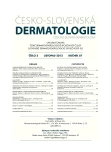Photodynamic Antiseptic Effect of Photoactive Nanofibers in the Treatment of Leg Ulcers
Authors:
P. Arenberger 1; M. Arenbergerová 1; S. Gkalpakiotis 1; J. Hugo 1; M. Bednář 2; P. Kubát 3; J. Mosinger 4,5
Authors‘ workplace:
Dermatovenerologická klinika 3. LFUK a FNKV, Praha
přednosta prof. MUDr. Petr Arenberger, DrSc., MBA
1; Ústav lékařské mikrobiologie 3. LFUK a FNKV, Praha
přednosta doc. MUDr. Marek Bednář, CSc.
2; Ústav fyzikální chemie J. Heyrovského AV ČR, Praha
ředitel prof. RNDr. Zdeněk Samec, DrSc.
3; Katedra anorganické chemie, Přírodovědecká fakulta UK, Praha
děkan fakulty prof. RNDr. Bohuslav Gaš, CSc.
4; Ústav anorganické chemie AV ČR, v. v. i., Řež
ředitelka Ing. Jana Bludská, CSc.
5
Published in:
Čes-slov Derm, 87, 2012, No. 5, p. 176-182
Category:
Pharmacologyand Therapy, Clinical Trials
Overview
Nanofiber textiles doped with 5,10,15,20-tetraphenylporphyrin (TPP) photosensitizer prepared by electrospinning from highly hydrophilic polyurethane TecophilicTM were characterized with microscopic methods and time-resolved spectroscopy. Complete inhibition of bacterial growth of the three tested bacterial strains on the surface of nanofiber textiles with encapsulated TPP was observed on illuminated samples in vitro. The antibacterial effect is based on photogeneration of cytotoxic singlet oxygen O2(1Δg) upon illumination by visible light. The antibacterial activity was also clinically tested in 162 patients with chronic leg ulcers. The application of illuminated doped nanofiber textiles yielded to a 35% decrease in wound size as assessed with computer aided wound tracing. The wound related pain estimated by the visual analogue scale declined by 71%. This methodology seems to be an effective alternative to topical antibiotics and antiseptics in chronic wounds and shows broad spectrum of application in medicine, particularly in dermatology, burn units and surgery.
Key words:
leg ulcer – nanofabrics – photosensitizer – photodynamic therapy
Sources
1. BILL, T. J., RATLIFF, C. R., DONOVAN, A. M. et al. Quantitative swab culture versus tissue biopsy: a comparison in chronic wounds. Ostomy Wound Manage, 2001, 47, p. 34–37.
2. CITRON, D. M., GOLDSTEIN, E. J., MERRIAM, C. V. et al. Bacteriology of moderate-to-severe diabetic foot infections and in vitro activity of antimicrobial agents. J. Clin. Microbiol., 2007, 45, p. 2819–2828.
3. DE ROSA, M. C., CRUTCHLEY, R. J. Photosensitized singlet oxygen and its applications. Coord. Chem. Rev., 2002, p. 233–234, p. 351–371.
4. EGOROV, S. Y., KAMALOV, V. F., KOROTEEV, N. I. et al. Rise and decay kinetics of photosensitized singlet oxygen luminescence in water. Measurements with nanosecond time-correlated single photon counting technique. Chem. Phys. Letters, 1989, 163, p. 421–424.
5. GIROTTI, A. W. Lipid hydroperoxide generation, turnover, and effector action in biological systems. J. Lipid Res., 1998, 39, p. 1529–1542.
6. GOTTRUP, F., JØRGENSEN, B., KARLSMARK, T. et al. Reducing wound pain in venous leg ulcers with Biatain Ibu: a randomized, controlled double-blind clinical investigation on the performance and safety. Wound Repair Regen, 2008, 16, p. 615–625.
7. GRACANIN, M., HAWKINS, C. L., PATTISON, D. I. et al. Singlet-oxygen-mediated amino acid and protein oxidation: Formation of tryptophan peroxides and decomposition products. Free Radical Biol. Med., 2009, 47, p. 92–102.
8. GROAH, S. L., LIBIN, A., SPUNGEN, M. et al. Regenerating matrix-based therapy for chronic wound healing: a prospective within-subject pilot study. Int. Wound J., 2011, 8, p. 85–95.
9. HARRIS, F., PIERPOINT, L. Photodynamic therapy based on 5-aminolevulinic acid and its use as an antimicrobial agent. Med. Res. Rev., 2011, Jul 26. doi 10.1002/med.20251. [Epub ahead of print]
10. JESENSKA, S., PLISTIL, L., KUBAT, P. et al. Antibacterial nanofiber materials activated by light. J. Biomed. Maters Res. A, 2011, 99, p. 676–683.
11. KIRKETERP-MØLLER, K., GOTTRUP, F. Bacterial biofilm in chronic wounds. Ugeskr Laeger, 2009, 171, p. 1097.
12. LANG, K., MOSINGER, J., WAGNEROVA, D. M. Photophysical properties of porphyrinoid sensitizers non-covalently bound to host molecules; models for photodynamic therapy. Coord. Chem. Rev., 2004, 248, p. 321–350.
13. MARTINS, A., CHUNG, S., PEDRO. A. J. et al. Hierarchical starch-based fibrous scaffold for bone tissue engineering applications. J. Tissue Eng. Regen. Med., 2009, 3, p. 37–42.
14. MOSINGER, J., JIRSAK, O., KUBAT, P. et al. Bactericidal nanofabrics based on photoproduction of singlet oxygen. J. Mater. Chem., 2007, 17, p. 164–166.
15. MOSINGER, J., LANG, K., HOSTOMSKY, J. et al. Singlet oxygen imaging in polymeric nanofibers by delayed fluorescence. J. Phys. Chem. B, 2010, 114, p. 15773–15779.
16. MOSINGER, J., LANG, K., KUBAT, P. et al. Photofunctional polyurethane nanofabrics doped by zinc tetraphenylporphyrin and zinc phthalocyanine photosensitizers. J. Fluorescence, 2009, 19, p. 705–713.
17. MOSINGER, J., LANG, K., PLISTIL, L. et al. Fluorescent polyurethane nanofabrics: A source of singlet oxygen and oxygen sensing. Langmuir, 2010, 26, p. 10050–10056.
18. NELSON, E. A., O’MEARA, S., GOLDER, S. et al. Systematic review of antimicrobial treatments for diabetic foot ulcers. Diabet. Med., 2006, 23, p. 348–359.
19. OMAR, N. S., EL-NAHAS, M. R., GRAY, J. Novel antibiotics for the management of diabetic foot infections. Int. J. Antimicrob. Agents, 2008, 31, p. 411–419.
20. O’MEARA, S., AL-KURD, I. D., OLOGUN, Y. et al. Antibiotics and antiseptics for venous leg ulcers. Cochrane Database Syst. Rev., 2010, CD003557.
21. RAFFETTO, J. D. The definition of the venous ulcer. J. Vasc. Surg., 2010, 52 (5 Suppl), p. 46–49.
22. SEN, C. K., GORDILLO, G. M., ROY, S., KIRSNER, R. et al. Human skin wounds: a major and snowballing threat to public health and the economy. Wound Repair Regen, 2009, 17, p. 763–771.
23. SCHNEIDER, M., KIRFEL, G., BERTHOLD, M. et al. The impact of antimicrobial photodynamic therapy in an artificial biofilm model. Lasers Med. Sci., 2011, 3, p. 615–620.
24. SCHULTZ, G. S., DAVIDSON, J. M., KIRSNER, R. S. et al. Dynamic reciprocity in the wound microenvironment. Wound Repair Regen, 2011, 19, p. 134–148.
Labels
Dermatology & STDs Paediatric dermatology & STDsArticle was published in
Czech-Slovak Dermatology

2012 Issue 5
Most read in this issue
- Cutaneous melanoma: Diagnosis, Treatment and Postoperative Follow-up
- Sarcoidosis: a Case with Less Common Clinical Manifestations
- Metastatic Melanoma Successfully Treated with Ipilimumab
- Photodynamic Antiseptic Effect of Photoactive Nanofibers in the Treatment of Leg Ulcers
